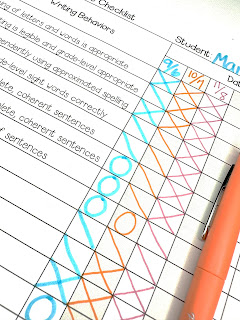Teaching and Assessing Writing in the Elementary Classroom
First Steps to Teaching Writing in the Elementary Classroom
If you find yourself intimidated by teaching writing in the elementary classroom, have no fear! I am here to help. Teaching writing, in my opinion, is one of the hardest subjects to teach and requires patience, thoughtfulness and preparation. In this post, I'll walk you through the steps of preparing to teach and assess writing in your elementary classroom.
Step One - A Writing Prompt
Determine your students' writing abilities. How? Assign a high interest writing prompt to pique their curiosity. It should be something about them, for example: I Like _____ Better than ______, or My Three Favorite Foods. It doesn't have to be that overtired narrative of What I did Over Summer Vacation (although, it has its place at the beginning of the school year). Make it something they're willing and excited to write about -- for more than a sentence or two.
Step Two - Assess the Writing Prompt
After students have completed their writing, collect them for review. You aren't going to grade these. You're going to assess them for strengths and areas of need. These completed prompts will give you your initial writing lessons simply based on the areas of need students show. This checklist is a lifesaver when it comes to helping you assess student writing samples.
 |
| Use this checklist to assess student writing samples throughout the school year. |
Step Three - Plan for Instruction
Make a list of the top three areas of need and build those skills into your writing workshop mini-lessons. More than likely, writing complete sentences -- robust, full and rich sentences-- is going to be one of the areas of need. This is where a resource like my Sentence Editing saves the day. It takes just a few minutes a day for students to edit a bland sentence by turning it into a sentence with at least 7 words. You'll be amazed by the depth of sentences your students can write when you model how to add more rich language to their sentences!
Step Four - Hold Regular Writing Conferences
Yes, I hear you saying this is going to take some time. It is time well-invested! And, once you get rolling with a system, it won't take as long as you think. Set aside one day a week to meet with a small group of students during the writing block, or set aside more than one day -- whatever works with your schedule. Sit down and have the child read the piece to you. (Make a copy of it for your file.) Discuss major strengths as you go through the checklist. Make note of one or two strengths you want to celebrate with the child on the anecdotal notes form. Also, as you listen and follow along as the student reads, you'll pick out one area of need to use for a goal. Ask the student what he/she thinks is the most important thing to improve. You may have the same skill in mind. I always have the child dictate the goal to me as I write it for them. I also write it on a sticky note to put in the child's writing folder. It remains there for them as a reminder.
Investing 5-8 minutes per student every month is an excellent way to see the student's growth and hone in on areas of need. It also helps strengthen your relationship with your student. Give it a try. Email me at msezzelltpt@gmail.com with questions or celebrations. I'd love to hear how this system works for you!
See Your Students' Writing Improve Over Time
As you continue to focus on the data the writing checklist and prompts provide you, implement more of the areas of need into your writers workshop or writing mini-lessons. Aim for collecting at least two work samples each grading period to help you determine the focus of lessons. It could be writing complete sentences, sentence punctuation, or writing sentences using richer vocabulary. With consistent attention to students' needs and including those concepts and skills in your writing workshop, you'll discover your students will make progress over time!
For more information on the prompts I use along with the checklist for identifying strengths and areas of need, click here.
As always...
Happy and Healthy Teaching!
Susan
Grade 2 Hullabaloo










